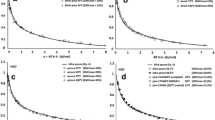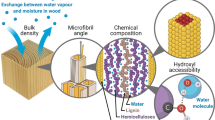Abstract
By expressing wood moisture content data as a function of adsorption energy, an interesting scaling capability is obtained, wherefrom the general hydrostatic pressure and temperature dependence of wood moisture content is determined. The scaling law is fully consistent with the thermodynamics of swelling. It can be used to transform room condition sorption isotherms to other temperatures and hydrostatic pressures, provided that the wood matrix is not irreversibly modified. A special procedure is suggested for the case of an irreversibly changing wood matrix, as in thermal modification and thermo-hydro-mechanical treatments. Using the present scaling theory, several fundamental aspects of wood moisture sorption are explained, such as the absence of a significant quantity of strongly bound wood moisture, the internal stress generation by sorption hysteresis in the wood cell wall, and the reason for the reversible disappearance of the sigmoid shape of the sorption isotherm at higher temperature. The results of this research may be useful (a) for transformation of known sorption data to other conditions, notably where in situ moisture measurements are difficult to perform and (b) to quantify the effects of internal stresses in the ultrastructure of the cell wall on moisture content.







Similar content being viewed by others
References
Åkerholm M, Salmén L (2004) Softening of wood polymers induced by moisture studied by dynamic FTIR spectroscopy. Appl Polym Sci 94:2032–2040
Allegretti O, Ferrari S (2008) A sensor for direct measurement of internal stress in wood during drying: experimental tests toward industrial application. Drying Technol 26:1150–1154
Almeida G, Gagné S, Hernández RE (2007) A NMR study of water distribution in hardwoods at several equilibrium moisture contents. Wood Sci Technol 41:293–307
Barkas WW (1949) The swelling of wood under stress. HM Stationary Office, London
Bhuiyan MTR, Hirai N, Sobue N (2000) Changes of crystallinity in wood cellulose by heat treatment under dried and moist conditions. Wood Sci 46:431–436
Cox J, McDonald PJ, Gardiner BA (2010) A study of water exchange in wood by means of 2D NMR relaxation correlation and exchange. Holzforschung 64:259–266
Cudinov BS (1966) The phenomenon of ‘negative swelling’ of wood perpendicular to grain during adsorption. In: Svojstva drevesiny, ee zascita, i novye drevesnye materialy. Izdat. Nauka, Moscow, pp 30–50
Engelund E, Thygesen L, Svensson S, Hill CAS (2013) A critical discussion of the physics of wood–water interactions. Wood Sci Technol 47:141–161
García Esteban L, de Palacios P, García Fernández F, Guindeo A, Conde M, Baonza V (2008) Sorption and thermodynamic properties of juvenile Pinus sylvestris L. wood after 103 years of submersion. Holzforschung 62:745–751
Glass SV, Zelinka SL (2010) Moisture relations and physical properties of wood. In: Wood Handbook, Chapter 04: General Technical Report FPL-GTR-190. U.S. Department of Agriculture, Forest Service, Forest Products Laboratory, Madison, pp 1–19
Gunderson DE (1991) Method for measuring mechanosorptive properties. Pulp Pap Sci 17:J53
Hill CAS (2008) The reduction in the fibre saturation point of wood due to chemical modification using anhydride reagents: a reappraisal. Holzforschung 62:423–428
Hill CAS, Ormondroyd GA (2004) Dimensional changes in Corsican pine (Pinus nigra Arnold) modified with acetic anhydride measured using a helium pycnometer. Holzforschung 58:544–547
Hill CAS, Norton A, Newman G (2009) The water vapor sorption behavior of natural fibers. Appl Polym Sci 112:1524–1537
Hill CAS, Norton AJ, Newman G (2010) The water vapour sorption properties of Sitka spruce determined using a dynamic vapour sorption apparatus. Wood Sci Technol 44:497–514
Hoffmeyer P, Thygesen LG, Engelund ET (2011) Equilibrium moisture content in Norway spruce during the first and second desorptions. Holzforschung 65:875–882
Hutson ND, Yang RT (1997) Theoretical basis for the Dubinin-Radushkevitch (DR) adsorption isotherm equation. Adsorption 3:189–195
Jalaludin Z, Hill CAS, Samsi HW, Husain H, Xie Y (2010) Analysis of water vapour sorption of oleo-thermal modified wood of Acacia mangium and Endospermum malaccense by a parallel exponential kinetics model and according to the Hailwood-Horrobin model. Holzforschung 64:763–770
Keating B, Hill CAS, Sun D, English R, Davies P, McCue C (2013) The water vapor sorption behavior of a galactomannan cellulose nanocomposite film analyzed using parallel exponential kinetics and the Kelvin-Voigt viscoelastic model. Appl Polym Sci 129:2352–2359
Luikov AV (1968) The Theory of Drying. Énergiya, Moscow
Mannes D, Sonderegger W, Pearson H, Lehmann E (2012) On-line monitoring of hygroscopicity changes of wood during thermal modification by means of neutron imaging methods. In: The Sixth European Conference on Wood Modification ECWM6 Proceedings. Ljubljana, Slovenia, pp 489–496
Matthews JF, Skopec CE, Mason PE, Zuccato P, Torget RW, Sugiyama J, Himmel ME, Brady JW (2006) Computer simulation studies of microcrystalline cellulose Iβ. Carbohydr Res 341:138–152
Nakano T (2006) Analysis of the temperature dependence of water sorption for wood on the basis of dual mode theory. Wood Sci 52:490–495
Navi P, Sandberg D (2012) Thermo-hydro-mechanical processing of wood. EFPL Press, Lausanne
Polanyi M (1916) Adsorption of gases (vapors) by a solid non-volatile adsorbent. Verh Dtsch Phys Ges 18:55–80
Rayirath P, Avramidis S, Mansfield SD (2008) The effect of wood drying on crystallinity and microfibril angle in black spruce (Picea mariana). J Wood Chem Technol 28:167–179
Salmén L (2004) Micromechanical understanding of the cell-wall structure. C R Biologies 327:873–880
Siau JF (1984) Transport processes in wood. Springer, Berlin
Simpson WT (1971) Moisture changes induced in red oak by transverse stress. Wood Fiber Sci 3:13–21
Skaar C (1988) Wood-water relations. Springer, Berlin
Stamm AJ, Loughborough WK (1935) Thermodynamics of the swelling of wood. Phys Chem 39:121–132
Stoeckli F (2001) Dubinin’s theory and its contribution to adsorption science. Russ Chem Bull 50:2265–2272
Suchy M, Virtanen J, Kontturi E, Vuorinen T (2010) Impact of drying on wood ultrastructure observed by deuterium exchange and photoacoustic FT-IR spectroscopy. Biomacromolecules 11:515–520
Thygesen LG, Elder T (2009) Moisture in untreated, acetylated, and furfurylated Norway Spruce monitored during drying below fiber saturation using time domain NMR. Wood Fiber Sci 41:194–200
Vidal Bastías M, Cloutier A (2005) Evaluation of wood sorption models for high temperatures. Maderas Ciencia y tecnología 7:145–158
Vrentas JS, Vrentas CM (1996) Hysteresis effects for sorption in glassy polymers. Macromolecules 29:4391–4396
Zabler S, Paris O, Burgert I, Fratzl P (2010) Moisture changes in the plant cell wall force cellulose crystallites to deform. Struct Biol 171:133–141
Author information
Authors and Affiliations
Corresponding author
Rights and permissions
About this article
Cite this article
Willems, W. Hydrostatic pressure and temperature dependence of wood moisture sorption isotherms. Wood Sci Technol 48, 483–498 (2014). https://doi.org/10.1007/s00226-014-0616-5
Received:
Published:
Issue Date:
DOI: https://doi.org/10.1007/s00226-014-0616-5




